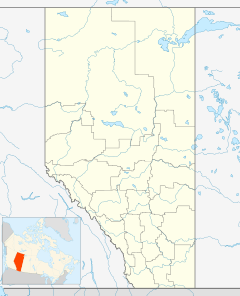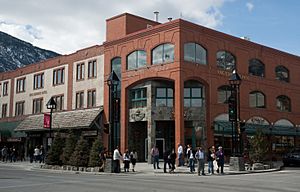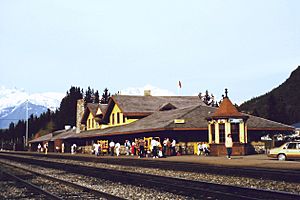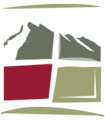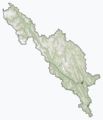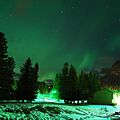Banff, Alberta facts for kids
Quick facts for kids
Banff
|
|||
|---|---|---|---|
|
Town
|
|||
| Town of Banff | |||
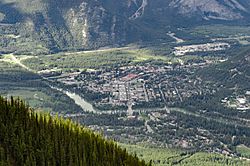
View of Banff
|
|||
|
|||
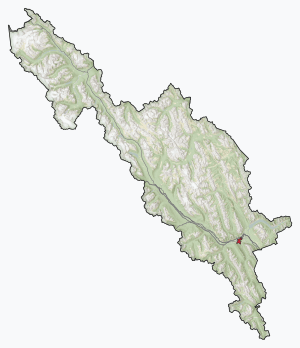
Location within Banff National Park
|
|||
| Country | Canada | ||
| Province | Alberta | ||
| Region | Alberta's Rockies | ||
| Census division | 15 | ||
| Improvement district | Improvement District No. 9 | ||
| Founded | 1885 | ||
| Incorporated | |||
| • Town | January 1, 1990 | ||
| Named for | Banff, Aberdeenshire | ||
| Area
(2021)
|
|||
| • Land | 4.08 km2 (1.58 sq mi) | ||
| Elevation | 1,400 m (4,600 ft) | ||
| Population
(2021)
|
|||
| • Total | 8,305 | ||
| • Density | 2,033.8/km2 (5,268/sq mi) | ||
| Demonym(s) | Banffite | ||
| Time zone | UTC−07:00 (MST) | ||
| • Summer (DST) | UTC−06:00 (MDT) | ||
| Forward sortation area |
T1L
|
||
| Area codes | +1-403, +1-587 | ||
| Public Transit Service | Roam | ||
Banff is a popular resort town located in Banff National Park in Alberta, Canada. It's nestled in the beautiful Alberta's Rockies mountains. You can find it along the Trans-Canada Highway, about 126 kilometers (78 miles) west of Calgary. The town sits high up, between 1,400 and 1,630 meters (4,590 to 5,350 feet) above sea level.
Banff was the first town to be officially set up inside a Canadian national park. It's a member of the Calgary Regional Partnership, which helps with planning in the Calgary area.
This town is one of Canada's most visited places for tourists. People love Banff for its amazing mountains and natural hot springs. It's a great spot for outdoor activities like hiking, biking, climbing (called scrambling), and skiing. You'll find famous ski resorts nearby, such as Sunshine Village, Ski Norquay, and Lake Louise Ski Resort.
Contents
What's in a Name? The Story of Banff's Name
The name Banff was chosen in 1884 by George Stephen. He was the president of the Canadian Pacific Railway. He named the area after his own birthplace, a town called Banff in Scotland. The railway company built many grand hotels along their train line, including the famous Banff Springs Hotel, to attract visitors from all over the world.
Banff's Past: A Look at Its History
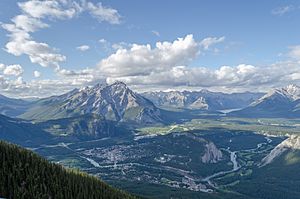
Banff began to be settled in the 1880s. This was after the transcontinental railway was built through the Bow Valley. In 1883, three workers from the Canadian Pacific Railway discovered natural hot springs on the side of Sulphur Mountain.
In 1885, Canada created a special protected area of 26 square kilometers (10 square miles) around the Cave and Basin hot springs. They started to promote this area as an international resort and spa. This helped support the new railway. By 1887, the protected area grew to 673 square kilometers (260 square miles) and was named "Rocky Mountain Park." This was the very beginning of Canada's National Park system!
The town of Banff grew near the railway station. It became a place where tourists could find services and supplies for their visits to the park. The Canadian government managed the town until 1990. That's when the Town of Banff became the only self-governing town inside a Canadian national park.
During World War I, some people were held in special camps in the Banff and Castle Mountain areas. These individuals helped build parts of the national park's infrastructure.
In 1985, the United Nations recognized Banff National Park as part of the Canadian Rocky Mountain Parks. They declared it a World Heritage Site. Today, Banff is still one of Canada's most popular places for tourists.
One important person in Banff's history was Norman Luxton, known as "Mr. Banff." He started the Crag and Canyon newspaper, built the King Edward Hotel and the Lux Theatre, and created the Sign of the Goat Curio Shop. This shop later led to the Buffalo Nations Museum. He and his family also helped organize popular events like the Banff Indian Days and the Banff Winter Carnival.
In 1976, a group of scientists named a crater on Mars "Banff" after the town in Alberta. The crater is about 5 kilometers (3.1 miles) wide.
Banff also hosted the 1991 Winter Deaflympics in 1991. This was the first time Canada hosted this international sports event for deaf athletes.
More recently, during the COVID-19 pandemic, the town decided to close parts of its main street to cars. This created a Downtown Pedestrian Zone for people to walk around safely. The town council plans to keep this pedestrian zone in place for a while.
Where is Banff? Its Geography
The town of Banff is surrounded by amazing mountains. Some of the most famous ones are Mount Rundle, Sulphur Mountain, Mount Norquay, and Cascade Mountain. The town is also located above Bow Falls, where the Bow River and Spray River meet.
Banff's Weather: What's the Climate Like?
Banff has a type of climate called a subarctic climate. This means it has long, cold winters and short, mild summers.
- In winter, temperatures usually range from an average low of -13.5°C (7.7°F) to an average high of -0.5°C (31.1°F).
- In summer, the warmest month sees average highs of 22.5°C (72.5°F) and average lows of 6.8°C (44.2°F).
It can even snow in any month of the year! On average, Banff gets about 183.8 centimeters (72.4 inches) of snow each year. The hottest temperature ever recorded in Banff was 37.8°C (100°F) on June 29, 2021.
| Climate data for Banff Climate ID: 3050520; coordinates 51°11′N 115°34′W / 51.183°N 115.567°W; elevation: 1,383.7 m (4,540 ft); 1991–2020 normals, extremes 1887−present |
|||||||||||||
|---|---|---|---|---|---|---|---|---|---|---|---|---|---|
| Month | Jan | Feb | Mar | Apr | May | Jun | Jul | Aug | Sep | Oct | Nov | Dec | Year |
| Record high humidex | 12.2 | 13.9 | 19.2 | 24.4 | 29.0 | 31.6 | 33.4 | 34.0 | 30.4 | 24.2 | 15.9 | 12.2 | 34.0 |
| Record high °C (°F) | 12.3 (54.1) |
14.7 (58.5) |
20.0 (68.0) |
25.6 (78.1) |
29.4 (84.9) |
37.8 (100.0) |
35.6 (96.1) |
34.2 (93.6) |
31.0 (87.8) |
26.5 (79.7) |
16.5 (61.7) |
12.5 (54.5) |
37.8 (100.0) |
| Mean daily maximum °C (°F) | −3.5 (25.7) |
−0.5 (31.1) |
3.7 (38.7) |
9.0 (48.2) |
14.3 (57.7) |
17.9 (64.2) |
22.5 (72.5) |
22.1 (71.8) |
16.7 (62.1) |
9.1 (48.4) |
0.6 (33.1) |
−4.6 (23.7) |
8.9 (48.0) |
| Daily mean °C (°F) | −8.5 (16.7) |
−6.6 (20.1) |
−2.2 (28.0) |
2.8 (37.0) |
7.4 (45.3) |
11.2 (52.2) |
14.7 (58.5) |
14.0 (57.2) |
9.4 (48.9) |
3.4 (38.1) |
−3.8 (25.2) |
−9.0 (15.8) |
2.7 (36.9) |
| Mean daily minimum °C (°F) | −13.5 (7.7) |
−12.6 (9.3) |
−8.2 (17.2) |
−3.5 (25.7) |
0.5 (32.9) |
4.4 (39.9) |
6.8 (44.2) |
5.8 (42.4) |
2.2 (36.0) |
−2.4 (27.7) |
−8.2 (17.2) |
−13.4 (7.9) |
−3.5 (25.7) |
| Record low °C (°F) | −51.2 (−60.2) |
−45.0 (−49.0) |
−40.6 (−41.1) |
−27.2 (−17.0) |
−17.8 (0.0) |
−4.1 (24.6) |
−3.2 (26.2) |
−4.5 (23.9) |
−16.7 (1.9) |
−27.0 (−16.6) |
−40.6 (−41.1) |
−48.3 (−54.9) |
−51.2 (−60.2) |
| Record low wind chill | −52.1 | −49.1 | −41.8 | −37.0 | −21.1 | −5.7 | −3.6 | −4.3 | −14.4 | −30.5 | −43.1 | −50.6 | −52.1 |
| Average precipitation mm (inches) | 18.8 (0.74) |
18.6 (0.73) |
29.3 (1.15) |
39.2 (1.54) |
50.0 (1.97) |
73.3 (2.89) |
46.9 (1.85) |
46.9 (1.85) |
44.9 (1.77) |
35.8 (1.41) |
27.8 (1.09) |
22.5 (0.89) |
454.0 (17.87) |
| Average rainfall mm (inches) | 1.6 (0.06) |
0.9 (0.04) |
6.6 (0.26) |
15.0 (0.59) |
37.9 (1.49) |
72.5 (2.85) |
46.7 (1.84) |
49.0 (1.93) |
39.9 (1.57) |
18.7 (0.74) |
5.5 (0.22) |
1.3 (0.05) |
295.7 (11.64) |
| Average snowfall cm (inches) | 21.2 (8.3) |
20.3 (8.0) |
25.3 (10.0) |
30.0 (11.8) |
12.3 (4.8) |
1.7 (0.7) |
0.1 (0.0) |
0.2 (0.1) |
7.9 (3.1) |
16.7 (6.6) |
25.2 (9.9) |
23.0 (9.1) |
183.8 (72.4) |
| Average precipitation days (≥ 0.2 mm) | 10.2 | 10.0 | 13.1 | 13.3 | 14.0 | 16.6 | 13.6 | 13.2 | 11.7 | 11.2 | 11.1 | 10.8 | 148.9 |
| Average rainy days (≥ 0.2 mm) | 0.59 | 0.60 | 2.6 | 4.7 | 12.3 | 16.5 | 12.8 | 12.8 | 10.2 | 6.9 | 2.0 | 1.1 | 83.0 |
| Average snowy days (≥ 0.2 cm) | 9.3 | 8.3 | 9.4 | 8.4 | 3.1 | 0.29 | 0.06 | 0.18 | 1.4 | 4.9 | 9.3 | 8.8 | 63.4 |
| Average relative humidity (%) (at 1500 LST) | 63.1 | 50.2 | 45.4 | 41.4 | 42.4 | 44.8 | 36.5 | 37.1 | 43.8 | 48.0 | 61.4 | 66.0 | 48.4 |
| Mean monthly sunshine hours | 58.9 | 93.2 | 127.1 | 159.0 | 201.5 | 207.0 | 254.2 | 213.9 | 171.0 | 130.2 | 81.0 | 43.4 | 1,740.4 |
| Mean daily sunshine hours | 1.9 | 3.3 | 4.1 | 5.3 | 6.5 | 6.9 | 8.2 | 6.9 | 5.7 | 4.2 | 2.7 | 1.4 | 4.8 |
| Source: Environment and Climate Change Canada (June maximum) (July maximum) (sun, 1948–1970) | |||||||||||||
Who Lives in Banff? Demographics
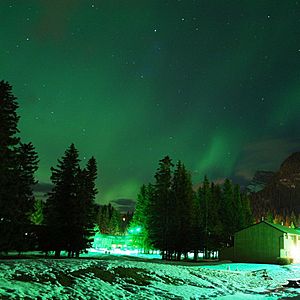
In 2021, the Town of Banff had a population of 8,305 people. This was an increase from its population of 7,851 in 2016. With a land area of 4.08 square kilometers (1.58 square miles), about 2,034 people lived in each square kilometer.
Parks Canada has special rules about who can live in Banff. These rules help make sure there are enough homes for people who work and raise families in the town.
Fun Things to Do: Banff's Attractions
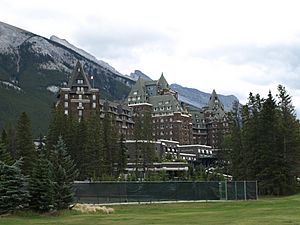
Many mountains are right next to the town. These include Mount Rundle (2,949 meters or 9,675 feet tall), Cascade Mountain (2,998 meters or 9,836 feet tall), and Mount Norquay (2,134 meters or 7,001 feet tall).
Mount Norquay has a ski slope and trails for mountain biking. You can also try a Via Ferrata, which is an assisted climbing experience. Another popular spot is the Banff Gondola. It takes you up Sulphur Mountain (2,281 meters or 7,484 feet tall). From the top, a boardwalk connects to Sanson Peak, and you can also visit the Banff Upper Hot Springs.
Lake Minnewanka is just a short drive north of Banff. It's a great place for a day trip with lots of activities. You can go mountain biking, hiking, and fishing there. There are also boat tours, motorboat rentals, and a small snack bar at the marina.
Tunnel Mountain (1,690 meters or 5,540 feet tall) is right in the town. You can hike to its top in less than half an hour! It got its name because early surveyors thought about building a tunnel for the Canadian Pacific Railway right through it. On the side of Tunnel Mountain, you'll find the Banff Centre for Arts and Creativity. This center hosts many events, like outdoor concerts, dance shows, opera, and theater.
Banff is also home to several famous festivals. These include the Banff World Television Festival, the Banff Mountain Film Festival, the Rocky Mountain Music Festival, and Bike Fest. The town is also the starting point for the 4,417-kilometer (2,744-mile) Great Divide Mountain Bike Route. This long biking trail ends in New Mexico, USA.
Sports and Events in Banff
Banff and a nearby town called Canmore hosted the 2014 Alberta Winter Games. As mentioned before, Banff also hosted the 1991 Winter Deaflympics. For many years, there has been an annual long-distance relay race between Banff and Jasper, Alberta. Banff has a long history of hosting training camps for Canada's national hockey teams. For example, the Canadian team for the 2012 World Junior Ice Hockey Championships trained here. The 1984 Canada Cup squad also practiced in Banff before their tournament.
Getting Around: Transportation in Banff
In 2008, the Banff town council started a local bus system called Roam. It has routes connecting the town, Tunnel Mountain, the Banff Springs Hotel, and the Banff Gondola. The buses are special hybrid vehicles, and each one is decorated with scenes from the National Park. Many bus stops even have screens that tell you exactly when the next buses will arrive!
In 2012, the bus system grew to include a route between Banff and Canmore. As of 2024, Roam Transit has 10 routes. Most of these serve places within Banff or nearby national park locations. Roam also has two routes to Lake Louise and a local service route within Canmore.
The railway first came to Banff when the Canadian Pacific Railway (CPR) line from Calgary opened in 1883. The current station building was opened by the CPR in 1910. In 1991, the Canadian government declared it a heritage railway station.
While long-distance passenger trains no longer stop in Banff, the railway station is still used by the Rocky Mountaineer and Royal Canadian Pacific tour trains. The closest major airport to Banff is the Calgary International Airport in Calgary.
Famous People from Banff
- Derek Beaulieu, a poet and publisher
- Sonya Lea, an award-winning author and filmmaker
- Karen Percy, a skier who won two bronze medals at the 1988 Winter Olympics
- J. Jill Robinson, an award-winning author
- Kevin Smyth, a former NHL player
- Ryan Smyth, a former NHL player
- Karen Sorensen, a former mayor and Canadian senator
Images for kids
See also
 In Spanish: Banff (Alberta) para niños
In Spanish: Banff (Alberta) para niños




